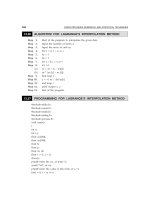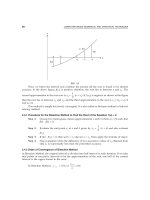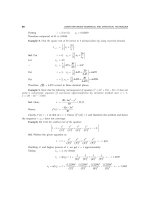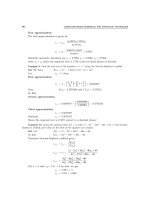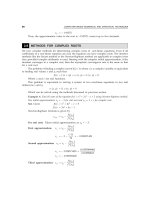A textbook of Computer Based Numerical and Statiscal Techniques part 19 pptx
Bạn đang xem bản rút gọn của tài liệu. Xem và tải ngay bản đầy đủ của tài liệu tại đây (106.78 KB, 10 trang )
166
COMPUTER BASED NUMERICAL AND STATISTICAL TECHNIQUES
∆∆ ∆ ∆
234
()
01
1
12 1
21
24 2 1
42
38 4
8
416
nPn
From Newton’s formula,
P(n)
23 4
(1)(1)(2)(1)(2)(3)
(0) (0) (0) (0) (0)
2! 3! 4!
xx xx x xx x x
PxP P P P
+−−−−−
=+∆+ ∆+ ∆+ ∆
(1)(1)(2)(1)(2)(3)
1
26 24
xx xx x xx x x
x
−−−−−−
=++ + +
232 432
311
1
2 2 6 6 3 24 4 24 4
xxx xx xx xx
x
=++−+−++−+ −
=
43
2
11 7
1.
24 12 12 12
xx
xx−+ + +
Ans.
Example 6. Find the value of sin 52
°
from the given table:
θ°°°°
θ
45 50 55 60
sin 0.7071 0.7660 0.8192 0.8660
Sol. Here a = 45
°
, h = 5, x = 52 therefore u = 1.4
°∆∆∆
°
°−
−
°−
°
4 4 42 43
10 10 10 10
45 7071
589
50 7660 57
532 7
55 8192 64
468
60 8660
xyyyy
INTERPOLATION WITH EQUAL INTERVAL
167
By forward interpolation formula
2
(1)
( ) () () ()
2!
uu
fa hu fa ufa fa
−
+= +∆+ ∆ +
⇒
4
10 ( )
fx
=
()
1.4 (0.4)( 0.6)
(1.4)(0.4)
7071 (1.4)589 ( 57) ( 7)
26
−
++ −+ −
= 7880
∴ f(52) = 0.7880 or sin 52
°
= 0.7880
Example 7. Following are the marks obtained by 492 candidates in a certain examination:
04040454550505555606065
. 2104354743279
Marks
No of Candidates
−−−−−−
Find out
(a) No. of candidates, if they secure more than 48 but less than 50 marks.
(b) Less than 48 but not less than 45 marks.
Sol. First we form the difference table as follows:
∆∆ ∆ ∆ ∆
−
−
−
2345
.
40 210
43
45 253 11
54 9
50 307 20 71
74 62 222
55 381 42 151
32 89
60 413 47
79
65 492
Marks less than No of Candidates
Here, h = 5,
For (a), x = 48, a = 40,
48 40
1.6
5
u
−
∴= =
Now on applying Newton’s forward difference formula, we have
1.6 0.6 1.6 (0.6)( 0.4) 1.6 (0.6)( 0.4)( 1.4)
(48) 210 1.6 4.3 11 9 ( 71)
26 24
f
××−×−−
=+×+ ×+ ×+ ×−
1.6 (0.6)( 0.4)( 1.4)( 2.4)
222
120
×−−−
+×
168
COMPUTER BASED NUMERICAL AND STATISTICAL TECHNIQUES
= 210 + 68.8 + 5.28 – 1.5904 – 0.576 – 2.38694
= 284.08 – 4.553344 = 279.52
≅
280
∴ No. of students secured more than 48 marks but less than 50 marks = 307 – 280 = 27
for (b), x = 48, a = 40, ∴ u = 1.6
1.6 0.6 1.6 (0.6)( 0.4) 1.6 (0.6)( 0.4)( 1.4)
(48) 210 1.6 4.3 11 9 ( 71)
26 24
f
××−×−−
=+×+ ×+ ×+ ×−
1.6 (0.6)( 0.4)( 1.4)( 2.4)
222
120
×−−−
+×
279.52 280=≅
∴ No. of students secured more than 45 marks but less than 48 marks = 280 –253 = 27
Example 8. Use Newton’s forward difference formula to obtain the interpolating polynomial f(x)
satisfying the following data:
1234
( ) 26 18 4 1
x
fx
If another point x = 5, f(x) = 26 is added to the above data, will the interpolating polynomial be the
same as before or different. Explain why?
Sol. The difference table is
∆∆∆∆
−
−
−
−
234
126
8
218 6
14 17
3 4 11 0
317
41 28
25
526
xy
As we seen here that its third difference is being constant either on taking fifth entry or on
not taking fifth entry (i.e., 26). So the interpolating polynomial should be same as before, and no
change will occur.
Here, h = 1, x = 5, a = 1
∴ u =
4
xa
h
−
=
f(x) = 26 + (x – 1)(x – 8)
()
1)( 2
(1)(2)(3)
(6) 17
2! 3!
xx
xxx
−−
−−−
+×−+ ×
INTERPOLATION WITH EQUAL INTERVAL
169
= 26 – 8x + x – 3x
2
+ 9x – 6 –
()
32
17
6116
6
xx x
−+−
=
232
17 187
28 3 17 17
66
xx x x x+−+−+−
=
32
17 193
20 11
66
xx x−+ +
which is the required interpolating polynomial.
Example 9. If p , q, r, s be the successive entries corresponding to equidistant arguments in a table.
Show that when third differences are taken into account, the entry corresponding to the argument half way
between the arguments at q and r is
+
B
A,
24
where A is the arithmetic mean of q and r and B is arithmetic
mean of 3q – 2p – s and 3r – 2s – p.
Sol. Given A is the arithmetic mean of q and r
⇒ A =
2
qr+
⇒ q + r = 2A
Also, B is the arithmetic means of 3q – 2p – s and 3r – 2s – p.
⇒Β=
32 32 3333
22
qpsrsp qpsr−−+−− −−+
=
Β=
3( ) 3( )
22
qr ps++
−
Let quantities p, q, r and s corresponds to argument a, a + h, a + 2h and a + 3h respectively
then the value of the argument lying half way between a + h and a + 2h will be
a + h +
2
h
i.e., a +
3
2
h
Hence,a + mh = a +
3
2
h
⇒ m =
3
2
Now, difference table as follows:
∆∆ ∆
−
+−+
−−+−
+−+
−
+
23
() () () ()
2
33
22
3
xfxfx fx fx
ap
qp
ah q r qp
rq s r qp
ah r srq
sr
ah s
Using Newton’s forward interpolation formula up to third difference only and taking
m = 3/2, we get
170
COMPUTER BASED NUMERICAL AND STATISTICAL TECHNIQUES
3
2
fa h
+
=
23
33 33 3
112
3
22 22 2
() () () ()
22 6
fa fa fa fa
−−−
+∆ + ∆ + ∆
=
33 1
()(2) (33)
28 16
pqp rqp srqp+−+−+− −+−
=
19
(99) ()
16 16 16
ps
pqrs qr
+
−+ + − = + −
=
923 91
(2 )
16 3 16 8 8 24
AB B
AAA
−
−=−+
=
24
B
A +
Example 10. The table below shows value of tan x for 0.10
≤
x
≤
0.30.
0.10 0.15 0.20 0.25 0.30
tan 0.1003 0.1511 0.2027 0.2553 0.3093
x
x
Evaluate tan 0.12 using Newton’s forward difference table.
Sol. Let us, first form the difference table.
∆∆ ∆ ∆
234
tan
0.10 0.1003
0.0508
0.15 0.1511 0.0008
0.0516 0.0002
0.20 0.2027 0.0010 0.0002
0.0526 0.0004
0.25 0.2553 0.0014
0.0540
0.30 0.3093
xx
Here, h = 0.05
a = 0.10, x = 0.12
∴ u =
0.12 0.10 0.02
0.4
0.05 0.05
xa
h
−−
===
∴ By using Newton’s forward difference formula, we get
f(u) = tan (0.12) = f(a) +
23 4
(1)(1)(2)(1)(2)(3)
() () () ()
2! 3! 4!
uu uu u uu u u
fa fa fa fa
−−−−−−
∆+ ∆+ ∆+ ∆
INTERPOLATION WITH EQUAL INTERVAL
171
=
0.4( 0.6) 0.4( 0.6)( 1.6)
0.1003 0.4 0.0508 (0.0008) (0.0002)
26
−−−
+× + × + ×
+
0.4( 0.6)( 1.6)( 2.6)
(0.0002)
24
−−−
×
= 0.1003 + 0.02032 – 0.000096 + 0.0000128 – 0.00000832
= 0.1206328 – 0.00010432
= 0.12052848 Approx.
PROBLEM SET 4.1
1. The population of a town in the decimal census was as given below. Estimate the population
for the year 1895.
93
1891 1901 1911 1921 1931
( ) 46 66 81 101
Year x
Population y in thousands
[Ans. 54.8528 thousands]
2. If l
x
represents the number of persons living at age x in a life table, find as accurately as
the data will permit l
x
for values of x = 35, 42 and 47. Given l
20
= 512, l
30
= 390, l
40
= 360,
l
50
= 243.
[Ans. 394, 326, 274]
3. From the following table, find the value of e
0.24
0.1 0.2 0.3 0.4 0.5
1.10517 1.22140 1.34986 1.49182 1.64872
x
x
e
[Ans. e
0.24
=1.271249]
4. From the table, Estimate the number of students who obtained marks between 40 and 45.
35
30 40 40 50 50 60 60 70 70 80
. 31 42 51 31
Marks
No of students
−−−−−
[Ans. 17]
5. Find the cubic polynomial which takes the following values
10
012 3
()121
x
fx
[Ans. 2x
3
-7x
2
+6x+1]
6. Find the number of men getting wages between Rs. 10 and Rs.15 from following table:
42
−−−− ( .) 010 1020 2030 3040
93035
Wages in Rs
Frequency
[Ans. 15]
172
COMPUTER BASED NUMERICAL AND STATISTICAL TECHNIQUES
7. The following are the numbers of deaths in four successive ten year age groups. Find the
number of deaths at 45-50 and 50-55.
31496
Age
Deaths
−−−− 25 35 35 45 45 55 55 65
13229 18139 24225
[Ans. 11278, 12947]
8. The following table give the marks secured by 100 students in Mathematics:
11
Range of marks
No of students
−−−−− 30 40 40 50 50 60 60 70 70 80
. 25 35 22 7
Use Newton’s forward difference interpolation formula to find
(1) the number of students who got more than 55 marks.
(2) the number of students who secured marks in the range from 36 to 45.
[Ans. (i) 28, (ii) 36]
9. From the following table of half-yearly premium for policies maturing at different ages,
estimate the premium for policies maturing at age of 46.
74.48
45 50 55 60 65
( ) 114.84 96.16 83.32 64.48
Age
Premium in Rupees
[Ans. Rs. 110.52]
4.3 NEWTON’S GREGORY FORMULA FOR BACKWARD INTERPOLATION
Let y = f(x) be a function of x which takes the values f(a), f(a + h), f(a + 2h), f(a+ nh) for
(n + 1) equally spaced values a, a + h, , a + nh of the independent variable x. Let us assume
f(x) be a nth degree polynomial given by
01 2
() ()()( 1) ()( 1)
n
fx A Axanh Axanhxan h Axahnxan h
=+−−+−−−−−+ −−−−−
(x – a – h) (1)
Where A
0
, A
1
, A
2
, A
n
are to be determined.
Put x = a + nh, a +
1, nh
−
a in (1) respectively.
Put x = a + nh, then f(a + nh) = A
0
(2)
Put x = a+ (n – 1)h, then
01 1
(1) ()
fa n h A hA fa nh hA+− = − = + −
(from 2)
⇒
1
()
fa nh
A
h
∇+
=
(3)
Put x = a + (n – 2)h, then
01 2
(2) 2(2)()
fa n h A hA h hA+− = − +− −
⇒
22
2
2! ( 2)()2() ()
hA fa n h fa nh fa nh fa nh=+−−++∇+=∇+
2
2
2
()
2!
fa nh
A
h
∇+
=
(4)
INTERPOLATION WITH EQUAL INTERVAL
173
Proceeding in similar way,
()
!
n
n
n
fa nh
A
nh
∇+
=
(5)
Substituting the vaues in (1), we get
()
( ) ( ) ( ) ( )( 1 )
fa nh
f x f a nh x a nh x a nh x a n h
h
∇+
=++−− + +−− −−−
()
( )
!
n
n
fa nh
xah
nh
∇+
−−
(6)
Put x = a +nh + uh, then x – a – nh = uh
and x – a – (n – 1)h = (u +1)h
x – a – h =
()
1un h
+−
∴ Equation (6) becomes
+
+
=++∇++ ∇+++ + +−∇
2
()
(1)
()()() () (1) ( 1)
2!
!
n
n
fa nh
uu
fx fa nh u fa nh fa nh uhu h u n h
nh
or
2
(1) (1)( 1)
( )() () () ()
2! !
n
uu uu u n h
fanhuh fanh ufanh fanh fanh
n
+++−
++=++∇++ ∇+++ ∇+
Which in required Newton’s Gregory formular for backward interpolation. This formula is
used when we want to interpolate the value near the end of the table.
Example 1. The table below gives the value of tan x for 0.10 ≤ x ≤ 0.30
x
x
: 0.10 0.15 0.20 0.25 0.30
tan : 0.1003 0.1511 0.2027 0.2553 0.3093
Find (a) tan 0.50 (b) tan 0.26 (c) tan 0.40
Sol. First of all we construct the difference table:
xx∇∇ ∇ ∇
234
tan
0.10 0.1003
0.0508
0.15 0.1511 0.0008
0.0516 0.0002
0.20 0.2027 0.0010 0.0002
0.0526 0.0004
0.25 0.2553 0.0014
0.0540
0.30 0.3093
174
COMPUTER BASED NUMERICAL AND STATISTICAL TECHNIQUES
(a) Here, h = 0.05, a = 0.30, x = 0.50
∴
0.50 0.30
4
0.05
u
−
==
tan (0.50) =
23 4
( 1) ( 1)( 2) ( 1)( 2)( 3)
() () () () ()
2! 3! 4!
uu uu u uu u u
fa u fa fa fa fa
++++++
+∇ + ∇ + ∇ + ∇
=
45 456 4567
0.3093 4 0.0540 0.0014 0.0004 0.0002
26 24
××××××
+× + × + × + ×
= 0.3093 + 0.216 + 0.014 + 0.008 + 0.007
= 0.5543
(b) Here, h = 0.05, a = 0.30, x = 0.26
∴ u =
0.26 0.30
0.8
0.05
−
=−
=
()
0.8 (0.2)
( 0.8) (0.2) (1.2)
0.3093 ( 0.8) 0.054 0.0014 0.0004
26
−×
−× ×
+− × + × + ×
( 0.8) (0.2) (1.2) (2.2)
0.0002
24
−×××
+×
= 0.3093 – 0.0432 – 0.000112 – 0.0000128 – 0.00000352
= 0.3093 – 0.04332882 ≅ 0.2662
(c) Here, h = 0.05, a = 0.30, x = 0.40
∴ u =
0.40 0.30
2
0.05
−
=
23
(1) (1)(2)
(0.40) tan(0.40) ( ) ( ) ( ) ( )
2! 3!
uu uu u
f fa u fa fa fa
+++
==+∇+∇+ ∇
4
(1)(2)(3)
()
4!
uu u u
fa
+++
+∇
On putting the subsequent values, we get
f(0.40) = 0.3093 + 2 × 0.054 +
23 234 2345
0.0014 0.0004 0.0002
26 24
××××××
×+ ×+ =
= 0.3093 + 0.108 + 0.0042 + 0.0016 + 0.0001
= 0.4241.
Example 2. Using Newton’s backward difference formula find the value of e
–1.9
from the following
table of value of e
–x
.
x
x
e
−
1 1.25 1.50 1.75 2.00
0.3679 0.2865 0.2231 0.1738 0.1353
INTERPOLATION WITH EQUAL INTERVAL
175
Sol. Difference table for the given data as follows:
234
1 0.3679
0.0814
1.25 0.2865 0.0180
0.0634 0.0039
1.50 0.2231 0.0141 0.0006
0.0493 0.0033
1.75 0.1738 0.0108
0.0385
2.00 0.1353
x
xe
−
∇∇ ∇ ∆
−
−−
−−
−
Here, u =
1.9 2
0.4
0.25
−
=−
using Newton’s backward difference formula
()
x
fe
−
=
23 4
(1) (1)(2) (1)(2)(3)
() () () () ()
2! 3! 4!
uu uu u uu u u
fa u fa fa fa fa
++++++
+∇ + ∇ + ∇ + ∇
On putting the subsequent values, we get
()
x
fe
−
= 0.1353 + (–0.4) × (–0.0385) +
()
−×−
×
0.4 ( 0.441)
0.0108
2
− ×−+−+
+×
( 0.4) ( 0.4 1)( 0.4 2)
(0.0033)
6
( 0.4) ( 0.4 1)( 0.4 2)( 0.4 3)
0.0006
24
− ×−+−+−+
+×
= 0.1353+0.0154 – 0.001296 + 0.0002112 + 0.000024
= 0.14959
Example 3. In the following table, values of y are consecutive terms of a series of which 23.6 is the
6th term. Find the first and tenth terms of the series.
x
y
34 5 6 7 8 9
4.8 8.4 14.5 23.6 36.2 52.8 73.9
